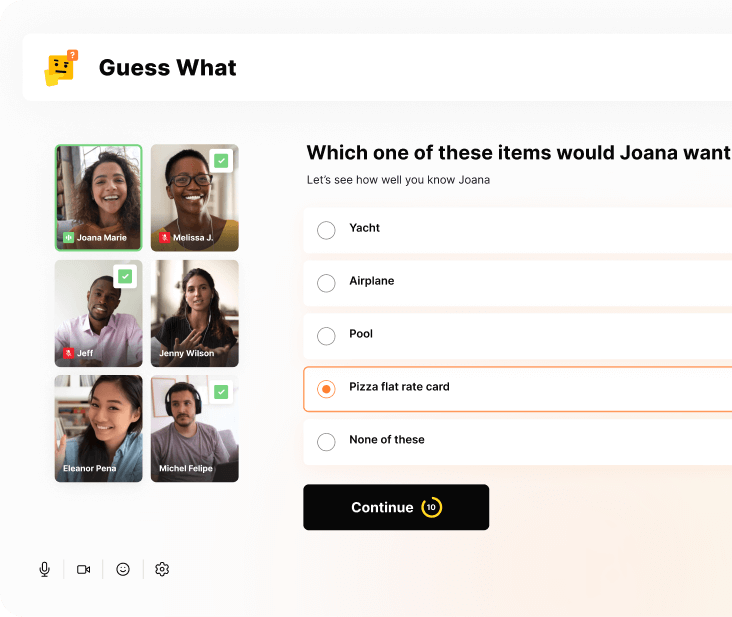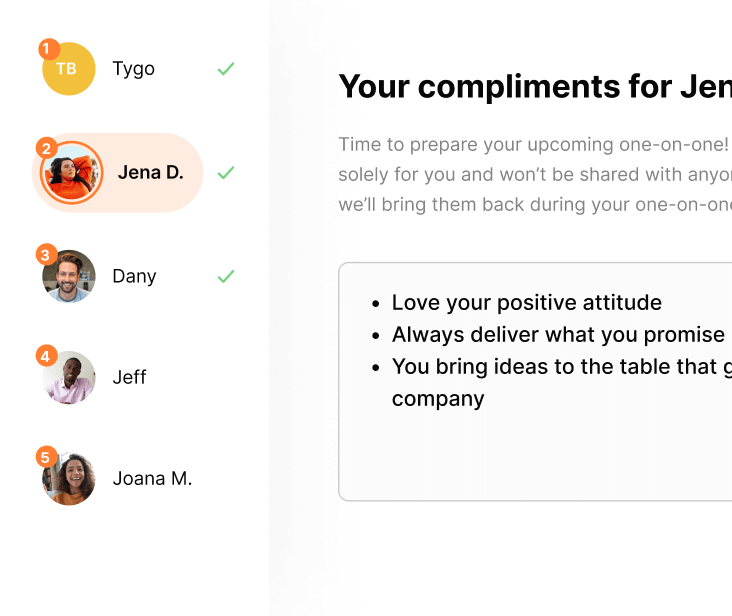Back to Blog
What is employee satisfaction? (+5 tips to boost it)
There's no denying that happy employees make for a better workplace. When employees are happy, they are more productive, more engaged with their work, and more likely to stick around.
Yet, only 42% of leaders in a Deloitte survey said their workers were happy in their jobs.
So, where are we going wrong? What is employee satisfaction? Here are the facts about job satisfaction and how you can improve it in your organization.
What is employee satisfaction? (Definition)
Employee satisfaction is a measurement of how happy employees are with their jobs. Satisfied employees are comfortable in their environment, happy in their roles, and content with their work.
You should note that employee satisfaction is different from employee engagement. Employee engagement looks at how connected an employee is to their company. But to define employee satisfaction, you examine feelings of contentment rather than connection.
Employee happiness is essential but doesn't guarantee productivity. Just because employees are happy doesn't mean they'll do a good job. Employee engagement and satisfaction must work together to boost performance.
Share fun facts and bond with a team quiz
Have your participants choose from a list of questions they’d like their coworkers to answer about them, before watching as they guess the right answer.
01. Yes
share-fun-facts-and-bond-with-a-team-quiz

Run a guided recognition activity
Have your participants choose from a list of questions they’d like their coworkers to answer about them, before watching as they guess the right answer.
01. Yes
run-a-guided-recognition-activity

Organize a virtual cooking class
Hire a professional chef to help your team cook a delicious lunch or dinner. May be difficult for co-workers with families. To find providers and get tips, read our blog about virtual cooking classes.
02. No
organize-a-virtual-cooking-class

Hire a stand-up comedian
Have your participants choose from a list of questions they’d like their coworkers to answer about them, before watching as they guess the right answer.
02. No
hire-a-stand-up-comedian

No items found
No items found
Table of contents
There's no denying that happy employees make for a better workplace. When employees are happy, they are more productive, more engaged with their work, and more likely to stick around.
Yet, only 42% of leaders in a Deloitte survey said their workers were happy in their jobs.
So, where are we going wrong? What is employee satisfaction? Here are the facts about job satisfaction and how you can improve it in your organization.
What is employee satisfaction? (Definition)
Employee satisfaction is a measurement of how happy employees are with their jobs. Satisfied employees are comfortable in their environment, happy in their roles, and content with their work.
You should note that employee satisfaction is different from employee engagement. Employee engagement looks at how connected an employee is to their company. But to define employee satisfaction, you examine feelings of contentment rather than connection.
Employee happiness is essential but doesn't guarantee productivity. Just because employees are happy doesn't mean they'll do a good job. Employee engagement and satisfaction must work together to boost performance.
Why is employee satisfaction important?
Satisfied employees offer plenty of benefits for their organizations. Oxford University found that happy employees are 13% more productive. This isn't because they work more hours, but because they work faster and more efficiently.
Satisfied employees are also more likely to stick around. Employee engagement statistics show that teams with low engagement have up to a 43% higher turnover rate. Since job satisfaction is directly related to engagement, increasing it can reduce turnover.
Further, satisfied employees make customers and clients happier. An in-depth study by Glassdoor revealed a clear link between employee and customer satisfaction. Each 1-star increase in a company's Glassdoor rating increased customer satisfaction by 1.3 points.
Finally, happy employees tend to be healthier. Researchers have found a direct link between job satisfaction and employee health. The less satisfied employees are, the more they experience sleep disorders, headaches, and anxiety.
What is good employee satisfaction?
Many companies don't know how to measure employee satisfaction or interpret their numbers.
Measuring employee satisfaction is key to understanding how satisfied your employees are. Tools like employee surveys and exit interviews are commonly used to measure happiness. Key performance indicators (KPIs) like the Employee Net Promoter Scores (eNPS) are also an option.
Understanding your team's employee satisfaction requires comparing KPIs with industry benchmarks. For example, any positive eNPS score is "good," and anything over 50 is "exceptional."
How can companies improve employee satisfaction?
Companies can do a lot to make their employees happier. Here are a few helpful tips to add to your employee engagement solutions to increase employee satisfaction.
Dive deeper into this topic with our dedicated article How to improve employee satisfaction.
1. Communicate openly and frequently
Employees need to feel involved and included to be happy. Keep your team in the loop about plans, changes, and company news. Encouraging and being open to feedback also shows them that you value their opinion.
Pro tip: Building relationships with your employees can make it easier for them to communicate with you.
2. Offer opportunities for growth
Growth and development are necessary for employees to feel satisfied at work. Provide them with opportunities for training, development, and advancement. Also, ensure they have access to the resources they need to succeed.
Pro tip: Try using an employee engagement platform to track goal progression and celebrate achievements.
3. Focus on team building
Relationships with team members are crucial to employee satisfaction. Teams are more productive and engaged when members feel connected, trusted, and respected. Foster relationships by encouraging collaboration and hosting team building activities for work.
Pro tip: Remote teams can invest in virtual team building activities like Gomada's activities, which aim to improve specific dimensions of your team.
4. Show appreciation
Feeling appreciated makes employees happier, so let them know you notice their hard work and value their efforts. You can recognize achievements in team meetings or offer rewards and bonuses. Thank you notes written by hand are also a nice touch.
Pro tip: Encourage peer-to-peer recognition with Gomada’s Appreciation Shower or other employee engagement app.
5. Support employee well-being
Promote well-being by offering perks like flexible hours and wellness programs. Make sure your employees feel supported by checking in regularly. Employees who feel supported and have a healthy work-life balance are more satisfied.
Promote well-being by offering perks like flexible hours, private remote health insurance and wellness programs.
Pro tip: For a healthy work-life balance, encourage employees to take vacation days and disconnect when away from the office.
Subscribe to get our latest updates
Subscribe to get our latest updates
.webp)



.jpg)

